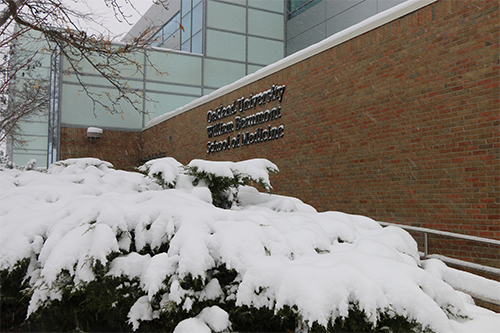
Luck appears to be running out for Oakland University William Beaumont School of Medicine medical students who have thus far avoided having to drive in a good old fashioned Michigan snowstorm.
According to the National Weather Service office in White Lake, a winter storm is expected to impact the region on Wednesday with accumulating snow. That includes an estimated 4-6 inches of snow predicted for Pontiac and its surrounding communities. Additional accumulation is expected on Friday and throughout the weekend.
The expected snowfall follows a dry winter — Oakland County received 10 inches less precipitation than normal in December, and January has been on a similar pace, per the National Integrated Drought Information System run by the National Oceanic and Atmospheric Administration.
But Michiganders know it’s only a matter of time before snow rolls through, which is why OUWB recently hosted a representative from AAA — The Auto Club Group of Michigan, to talk about driving and car safety in the winter.
“This event is always especially useful for our students that come from out of state, but for any of us it is a good refresher as we head into winter,” said Katy Torma, administrative coordinator, Student Affairs.
“We spend so many months out of the year driving in icy or snowy conditions that it's important to be prepared for a variety of scenarios that may occur,” she added.
OUWB medical students like Christian Santiago, M1, were among those who attended.
“I’m from Florida and we have no chance of driving in snow, ever,” he said. “This was a great chance for me to really understand the skills I need to be prepared for travel in Michigan or other parts of the Midwest.”
‘A little more seriously’
Rachel Wilson, lead instructor, AAA – The Auto Club Group of Michigan, presented the session in OUWB’s O’Dowd Hall.
Wilson said even for the most hardened Michigan driver, the first big snow event of the year can present challenges.
“The first time we get a snowstorm, it seems like we forget how to drive in it,” she said.
Further, drivers who are new to snowstorms “may have no concept of how difficult it can be, and how different it can be than even driving in rain.”
If nothing else, she said, the hope is that everyone takes driving in a snowstorm “a little more seriously.”
Wilson talked at length about one of the biggest issues: reduced traction.
The key, she said, is adjusting speed — the slower you go, the better traction.
“I’m talking about varying degrees of how slow you have to go,” she said. “If it’s just flurries, you may have to slow down 5 to 10 percent. If there’s a lot of snow, you may have to slow down so much you feel like you are literally crawling.”
Wilson suggests drivers who are new to snow err on the side of caution until they get a feel for driving in inclement winter weather. One way to do so, she said, is find a big open parking lot where there are no other vehicles, poles, etc., and hit the brakes at certain speeds.
Another tip, she said, is to allow for at least 7 seconds of stopping distance between your vehicle and the one in front of you. This allows for plenty of space to move in case of emergency.
“You always want to have a plan B,” she said. “Make sure you can stop in time if the vehicle in front of you suddenly hits the brakes.”
Other tips offered by Wilson included:
- Warm your vehicle in an open space with snow cleared away (especially around the exhaust).
- Before moving your vehicle, clear all windows — not just one “hole” where you can see a fraction of the road.
- Clean off the hood of your vehicle to avoid having snow blow towards the windshield and essentially creating a “mini-blizzard.”
- If you start to skid, look and steer toward where you want to go.
- Use safe driving practices, such as wearing a seat belt and staying focused.
- Don’t be overly reliant on vehicle technology, such as rear cameras and other sensors that can be covered with dirt, slush, salt, etc.
- Keep your headlights on so other drivers can see you better.
- If you have snow/ice build up on your windshield wipers, get off the road and clear them.
- If you get stuck, clear snow away from tires and try spreading sand or kitty litter near your tires to gain traction.
- Prepare your car for safe travels (see graphic below).
-page-001.jpg)
For more information, contact Andrew Dietderich, marketing writer, OUWB, at [email protected].
To request an interview, visit the OUWB Communications & Marketing webpage.
This work is licensed under a Creative Commons Attribution-NonCommercial 4.0 International License.

